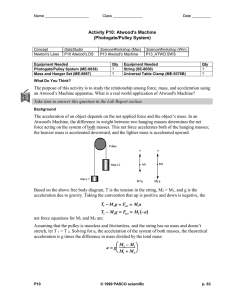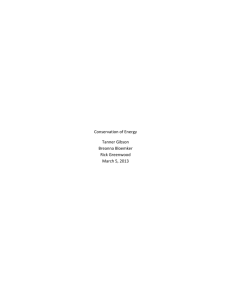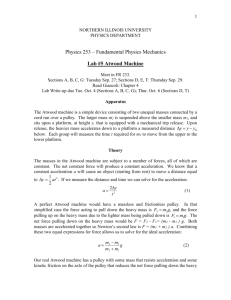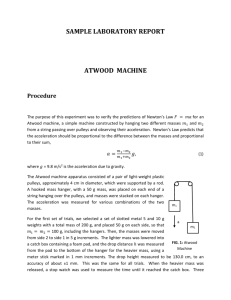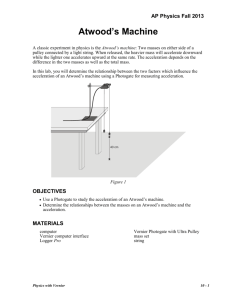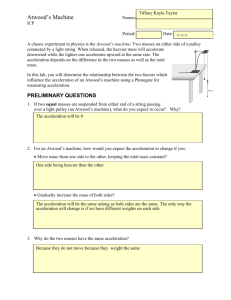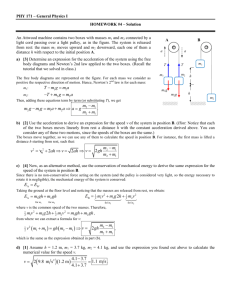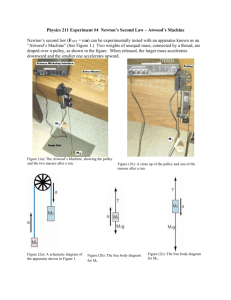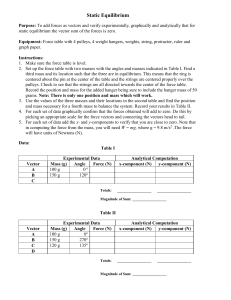Activity P10: Atwood's Machine (Photogate/Pulley System) The
advertisement
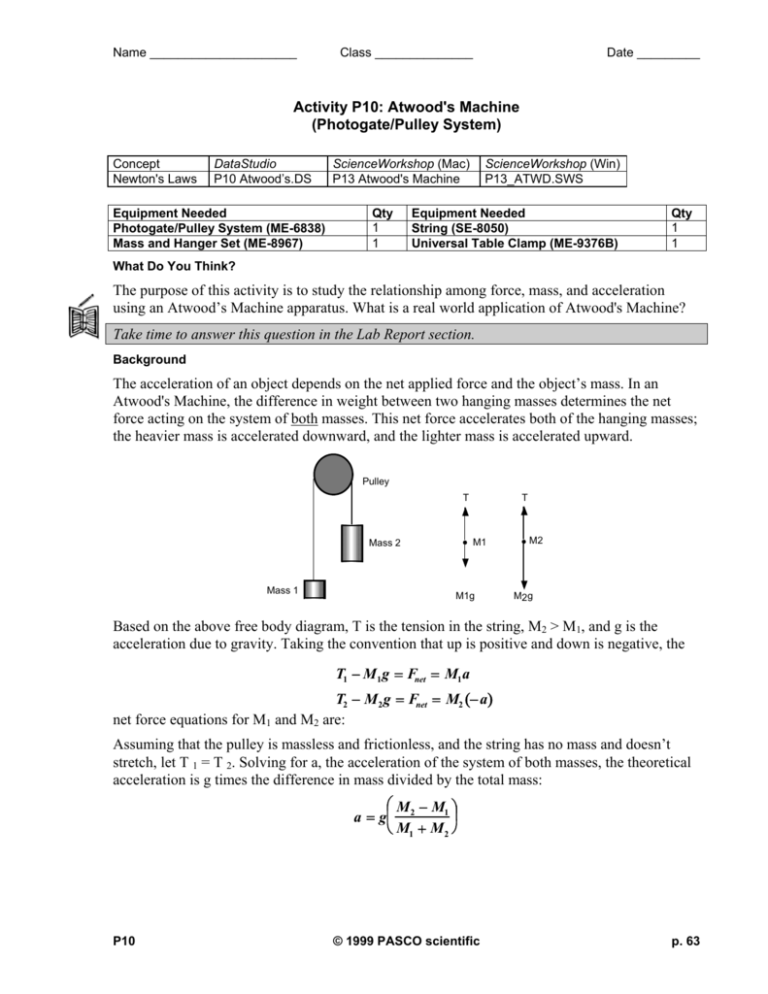
Name _____________________ Class ______________ Date _________ Activity P10: Atwood's Machine (Photogate/Pulley System) Concept Newton's Laws DataStudio P10 Atwood’s.DS Equipment Needed Photogate/Pulley System (ME-6838) Mass and Hanger Set (ME-8967) ScienceWorkshop (Mac) P13 Atwood's Machine Qty 1 1 ScienceWorkshop (Win) P13_ATWD.SWS Equipment Needed String (SE-8050) Universal Table Clamp (ME-9376B) Qty 1 1 What Do You Think? The purpose of this activity is to study the relationship among force, mass, and acceleration using an Atwood’s Machine apparatus. What is a real world application of Atwood's Machine? Take time to answer this question in the Lab Report section. Background The acceleration of an object depends on the net applied force and the object’s mass. In an Atwood's Machine, the difference in weight between two hanging masses determines the net force acting on the system of both masses. This net force accelerates both of the hanging masses; the heavier mass is accelerated downward, and the lighter mass is accelerated upward. Pulley T M1 Mass 2 Mass 1 T M1g M2 M2 g Based on the above free body diagram, T is the tension in the string, M2 > M1, and g is the acceleration due to gravity. Taking the convention that up is positive and down is negative, the T1 − M 1 g = Fnet = M1 a T2 − M2 g = Fnet = M2 (− a) net force equations for M1 and M2 are: Assuming that the pulley is massless and frictionless, and the string has no mass and doesn’t stretch, let T 1 = T 2. Solving for a, the acceleration of the system of both masses, the theoretical acceleration is g times the difference in mass divided by the total mass: ⎛ M − M1 ⎞ ⎟ a = g⎜ 2 ⎝ M1 + M 2 ⎠ P10 © 1999 PASCO scientific p. 63 Physics Labs with Computers, Vol. 1 P10: Atwood’s Machine Student Workbook 012-07000A SAFETY REMINDERS • Follow all directions for using the equipment. For You To Do Use the Photogate/Pulley System to measure the motion of both masses as one moves up and the other moves down. Use DataStudio or ScienceWorkshop to record the changing speed of the masses as they move. The slope of the graph of velocity vs. time is the acceleration of the system. PART I: Computer Setup Sc 1. Connect the ScienceWorkshop interface to the computer, turn on the interface, and turn on the computer. ien ce Wo rks ho p™ DA TA LO GG ING INS TR NS PA In 2. Connect the Photogate’s phone plug to Digital Channel 1 on the interface. UC TIO 500 scieSC terfac ntifi O e c APN AA scieSLO C ntifi GOCH c AN NE LS S Worcien kshoce p™ 300 Inte rfa 3. ce Open the document titled as shown: DataStudio P10 Atwood’s.DS ScienceWorkshop (Mac) P13 Atwood's Machine ScienceWorkshop (Win) P13_ATWD.SWS • The DataStudio document has a Workbook display. Read the instructions in the Workbook. • The ScienceWorkshop document has a Graph display of velocity versus time. • Note: The spoke arc length for the Pulley is set at 0.015 m. If you are using a different pulley, change the spoke arc length in the sensor window by double clicking on the sensor’s icon in the Experiment Setup window. PART II: Sensor Calibration and Equipment Setup • You do not need to calibrate the sensor. 1. Mount the clamp to the edge of a table. 2. Use the Pulley Mounting Rod to attach the Pulley to the tab on the Photogate. 3. Place Photogate/Pulley in the clamp so that the rod is horizontal. 4. Use a piece of string about 10 cm longer than the distance from the top of the pulley to the floor. Place the string in the groove of the pulley. 5. Fasten mass hangers to each end of the string. • To attach the string to the hanger, form a loop at the end of the string and tie it back on itself to ‘knot it’ or wrap the string about 5 times around the notch in the mass hanger. p. 64 © 1999 PASCO scientific P10 Name _____________________ 6. P10 Class ______________ Date _________ Place five to six masses from your mass set, totaling (roughly) 100 grams of mass on one mass hanger and record the total mass as M1 in the Data Table in the Lab Report section. Be sure to include the 5 grams from the mass hanger in the total mass. On the other mass hanger, place about six masses, totaling slightly more mass than M1. Record this total mass of the masses and mass hanger as M2 in the Data Table in the Lab Report section. © 1999 PASCO scientific p. 65 Physics Labs with Computers, Vol. 1 P10: Atwood’s Machine 7. Student Workbook 012-07000A Move the M2 mass hanger of upward until the M1 mass hanger almost touches the floor. Hold the M2 mass hanger to keep it from falling. Turn the pulley so that the Photogate beam is unblocked (the red light-emitting diode (LED) on the Photogate does not light). PART IIIA: Data Recording – Constant Total Mass 1. Release the M2 mass hanger and let it fall. Start recording data. 2. Stop recording just before the M2 mass hanger reaches the floor. • Do not let the upward moving mass hit the Pulley. • “Run #1” will appear in the Data list. 3. For Run #2, move a mass from the M2 mass hanger to the M1 mass hanger. This process changes the net force without changing the total system mass. Record the new total mass for each hanger with masses in the Data Table in the Lab Report section. Allow the mass to fall. Begin data recording. Stop recording data just before the hanger reaches the floor. 4. Repeat the above step to create three more mass combinations. For each run, the net force changes but the total mass of the system remains constant. PART IIIB: Data Recording – Constant Net Force 1. Arrange the masses as they were for Run #1. Now, change the total mass of the system but keep the net force the same. To do this, add exactly the same amount of additional mass to both mass hangers. • Make sure that the difference in mass is the same as it was for the beginning of Part IIIA. 2. Add approximately 10 grams to each mass hanger. Record the new total mass for each hanger with masses in the Data Table in the Lab Report section. Release the M2 mass hanger and let it fall. Start data recording. Stop recording just before the M2 mass hanger reaches the floor. 3. Repeat the above step to create three more data runs. For each data run, the net force remains the same, but the total mass of the system changes. p. 66 © 1999 PASCO scientific P10 Name _____________________ Class ______________ Date _________ Analyzing the Data 1. Determine the experimental acceleration for each of the data runs. • Click in the Graph display to make it active. Find the slope of the velocity vs. time plot, the average acceleration of the masses. • In DataStudio, select Run #1 from the Data Menu ( ) in the Graph display. If multiple data runs are showing, first select No Data from the Data Menu and then select Run #1. Click the “Scale to fit” button ( Next, click the ‘Fit’ menu button ( • ) to rescale the Graph axes to fit the data. ). Select ‘Linear’. ) in the Graph display. If In ScienceWorkshop, select Run #1 from the Data Menu ( multiple data runs are showing, first select No Data from the Data Menu and then select Run #1. Click the “Autoscale” button ( ) to rescale the Graph axes to fit the data. Click the ‘Statistics’ button to open the Statistics area on the right side of the Graph. In the Statistics area, click the Statistics Menu button ( the Statistics Menu. ). Select ‘Curve Fit, Linear Fit’ from • Record the slope of the linear fit in the Data Table in the Lab Report section. Repeat the above procedure for each of the remaining 9 data runs. 2. For each of the data runs, using the measured mass values, calculate and record the net force in the Data Table in the Lab Report section. Fnet = (M2 − M1 )g 3. Calculate and record the total mass in the Data Table. 4. Using the total mass and net force, calculate the theoretical acceleration using: Fnet a= M1 + M2 5. For each data run, calculate and record the percent difference between the experimental acceleration and the theoretical acceleration. Record your results in the Lab Report section. P10 © 1999 PASCO scientific p. 67 Physics Labs with Computers, Vol. 1 P10: Atwood’s Machine Student Workbook 012-07000A Lab Report - Activity P10: Atwood's Machine What Do You Think? What is a real world application of Atwood's Machine? Data Table: Constant Total Mass M1 (kg) Run M2 (kg) aexp (m/s2) Fnet (N) M1+ M2 (kg) atheory (m/s2) Percent difference aexp (m/s2) Fnet (N) M1+ M2 (kg) atheory (m/s2) Percent difference Run #1 Run #2 Run #3 Run #4 Run #5 Data Table: Constant Net Force M1 (kg) Run M2 (kg) Run #6 Run #7 Run #8 Run #9 Run #10 Questions 1. p. 68 Compare the experimental acceleration with the theoretical acceleration by determining the percentage difference. What are some reasons that would account for this percent difference? © 1999 PASCO scientific P10 Name _____________________ Class ______________ Date _________ 2. For the Constant Total Mass data, plot a graph of Fnet vs. aexp. Note: Include a negative sign for acceleration values when M1 > M2. Attach your plot to the Lab Report. 3. Draw the best-fit line on your plot. What does the slope of the best-fit line represent? 4. How does the Force vs. Acceleration plot relate to Newton’s Second Law? P10 © 1999 PASCO scientific p. 69
